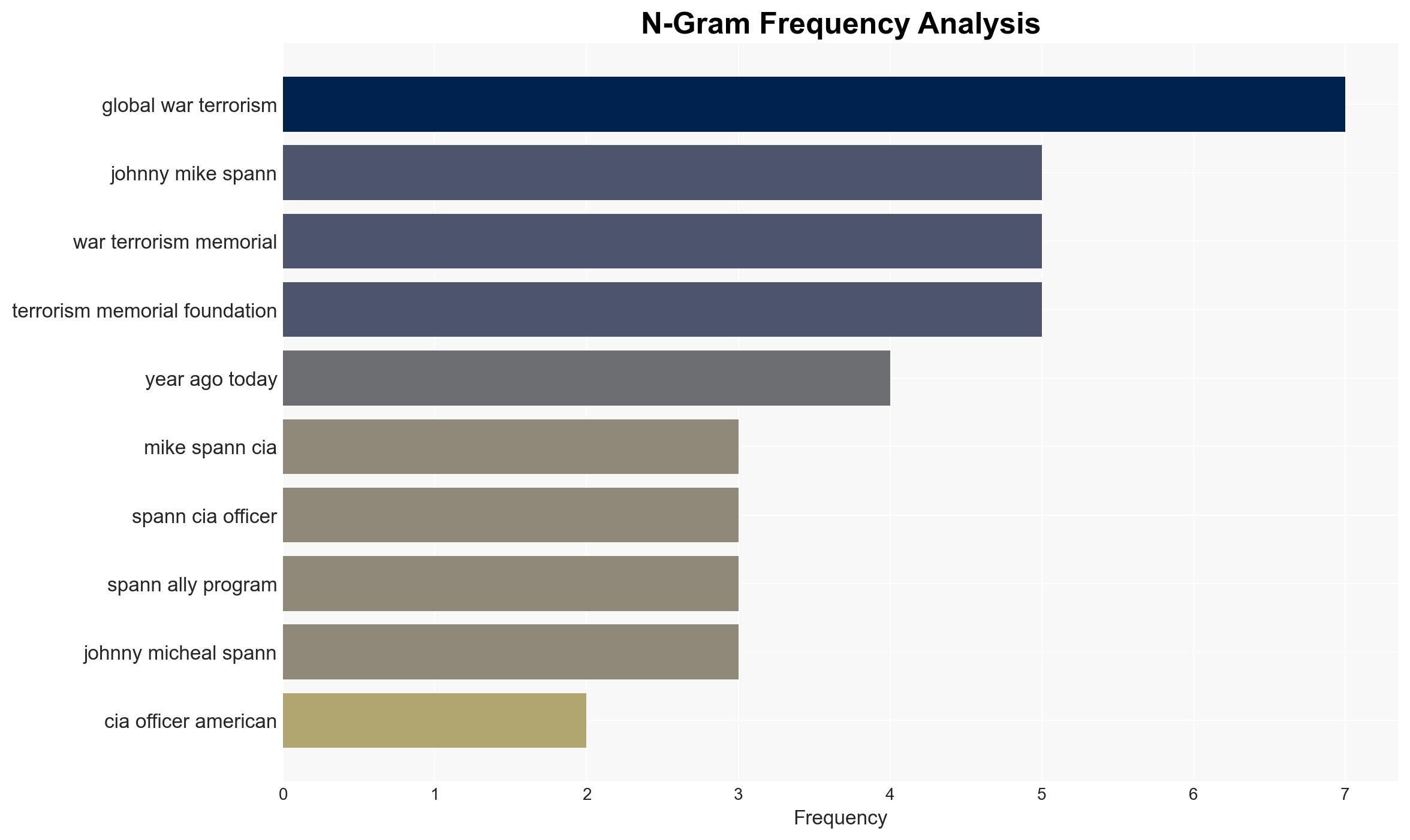Remembering Johnny Mike Spann: First American CIA Officer Killed in Afghanistan, 24 Years Ago Today
Published on: 2025-11-26
AI-powered OSINT brief from verified open sources. Automated NLP signal extraction with human verification. See our Methodology and Why WorldWideWatchers.
Intelligence Report:
1. BLUF (Bottom Line Up Front)
The most supported hypothesis is that the commemoration of Johnny Mike Spann’s death serves as a strategic narrative to reinforce the legacy of U.S. involvement in Afghanistan, emphasizing sacrifice and commitment in the Global War on Terrorism. This narrative could potentially be leveraged to bolster current U.S. counter-terrorism policies and alliances. Confidence Level: Moderate.
2. Competing Hypotheses
Hypothesis 1: The commemoration of Johnny Mike Spann’s death is primarily a symbolic gesture aimed at honoring his sacrifice and reinforcing the historical narrative of U.S. involvement in Afghanistan.
Hypothesis 2: The commemoration is strategically utilized to reignite public and political support for ongoing counter-terrorism efforts and to strengthen alliances under the Global War on Terrorism Memorial Foundation’s initiatives.
The evidence leans towards Hypothesis 2 due to the structured efforts by the Global War on Terrorism Memorial Foundation to align Spann’s legacy with ongoing counter-terrorism narratives and initiatives, suggesting a broader strategic intent beyond mere commemoration.
3. Key Assumptions and Red Flags
Assumptions: It is assumed that the narrative around Johnny Mike Spann is being actively used to influence current policy and public opinion. It is also assumed that the Global War on Terrorism Memorial Foundation has significant influence in shaping these narratives.
Red Flags: Potential bias in the portrayal of events to align with specific political or military agendas. The risk of overemphasizing individual narratives to overshadow broader strategic failures or challenges in Afghanistan.
Deception Indicators: Lack of critical perspectives in the narrative could indicate an attempt to control the narrative for strategic purposes.
4. Implications and Strategic Risks
The strategic use of Johnny Mike Spann’s legacy could lead to increased public support for counter-terrorism initiatives, potentially justifying further military or political actions. However, there is a risk of backlash if the narrative is perceived as manipulative or if it fails to acknowledge the complexities of the Afghanistan conflict. This could lead to political polarization or decreased trust in military and governmental institutions.
5. Recommendations and Outlook
- Ensure balanced narratives that acknowledge both the sacrifices and the complexities of the Afghanistan conflict to maintain public trust.
- Leverage the commemoration to strengthen alliances and reinforce commitments to global counter-terrorism efforts.
- Best-case scenario: Enhanced public and political support for counter-terrorism initiatives, leading to stronger international alliances.
- Worst-case scenario: Public backlash and decreased trust in military and governmental institutions due to perceived manipulation of narratives.
- Most-likely scenario: Moderate increase in support for counter-terrorism policies with some public skepticism.
6. Key Individuals and Entities
Johnny Mike Spann, Shannon Spann, Abdul Radhis Dostum, John Walker Lindh, Michael “Rod” Rodríguez.
7. Thematic Tags
Structured Analytic Techniques Applied
- ACH 2.0: Reconstruct likely threat actor intentions via hypothesis testing and structured refutation.
- Indicators Development: Track radicalization signals and propaganda patterns to anticipate operational planning.
- Narrative Pattern Analysis: Analyze spread/adaptation of ideological narratives for recruitment/incitement signals.
Explore more:
Counter-Terrorism Briefs ·
Daily Summary ·
Support us





